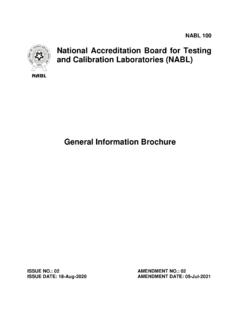Transcription of General requirements for the competence of testing and …
1 General requirements for the competence of testing and calibration laboratoriesExigences g n rales concernant la comp tence des laboratoires d' talonnages et d'essaisINTERNATIONAL STANDAR DISO/IEC17025 Third edition2017-11 Reference numberISO/IEC 17025:2017(E) ISO/IEC 2017 ii ISO/IEC 2017 All rights reservedCOPYRIGHT PROTECTED DOCUMENT ISO/IEC 2017, Published in SwitzerlandAll rights reserved. Unless otherwise specified, no part of this publication may be reproduced or utilized otherwise in any form or by any means, electronic or mechanical, including photocopying, or posting on the internet or an intranet, without prior written permission.
2 Permission can be requested from either ISO at the address below or ISO s member body in the country of the copyright officeCh. de Blandonnet 8 CP 401CH-1214 Vernier, Geneva, SwitzerlandTel. +41 22 749 01 11 Fax +41 22 749 09 17025:2017(E) ISO/IEC 17025:2017(E) Foreword ..vIntroduction ..vi1 Scope ..12 Normative references ..13 Terms and definitions ..14 General requirements .. Impartiality .. Confidentiality ..35 Structural requirements ..46 Resource requirements .. General .. Personnel .. Facilities and environmental conditions .. Equipment .. Metrological traceability.
3 Externally provided products and services ..87 Process requirements .. Review of requests, tenders and contracts .. Selection, verification and validation of Selection and verification of methods .. Validation of methods .. Sampling .. Handling of test or calibration items .. Technical records .. E valuation of measurement uncertainty .. Ensuring the validity of results .. Reporting of results .. Common requirements for reports (test, calibration or sampling) .. Specific requirements for test reports .. Specific requirements for calibration certificates .. Reporting sampling specific requirements .
4 Reporting statements of conformity .. Reporting opinions and interpretations .. Amendments to reports .. Complaints .. Nonconforming work .. Control of data and information management ..198 Management system requirements .. Options .. Option A .. Option B .. Management system documentation (Option A) .. Control of management system documents (Option A) .. Control of records (Option A).. Actions to address risks and opportunities (Option A) .. Improvement (Option A) .. Corrective actions (Option A) .. Internal audits (Option A) .. Management reviews (Option A).
5 23 ISO/IEC 2017 All rights reserved iiiContents Page ISO/IEC 17025:2017(E) Annex A (informative) Metrological traceability ..25 Annex B (informative) Management system options ..27 Bibliography ..29iv ISO/IEC 2017 All rights reserved ISO/IEC 17025:2017(E)ForewordISO (the international Organization for Standardization) is a worldwide federation of national standards bodies (ISO member bodies). The work of preparing international Standards is normally carried out through ISO technical committees. Each member body interested in a subject for which a technical committee has been established has the right to be represented on that committee.
6 international organizations, governmental and non-governmental, in liaison with ISO, also take part in the work. In the field of conformity assessment, ISO and the international electrotechnical commission (IEC) develop joint ISO/IEC documents under the management of the ISO Committee on Conformity assessment (ISO/CASCO).The procedures used to develop this document and those intended for its further maintenance are described in the ISO/IEC Directives, Part 1. In particular the different approval criteria needed for the different types of ISO documents should be noted. This document was drafted in accordance with the editorial rules of the ISO/IEC Directives, Part 2 (see ).
7 Attention is drawn to the possibility that some of the elements of this document may be the subject of patent rights. ISO shall not be held responsible for identifying any or all such patent rights. Details of any patent rights identified during the development of the document will be in the Introduction and/or on the ISO list of patent declarations received (see ).Any trade name used in this document is information given for the convenience of users and does not constitute an an explanation on the voluntary nature of standards, the meaning of ISO specific terms and expressions related to conformity assessment, as well as information about ISO's adherence to the World Trade Organization (WTO) principles in the Technical Barriers to Trade (TBT) see the following URL.
8 Document was prepared by the ISO Committee on Conformity Assessment (CASCO) and circulated for voting to the national bodies of both ISO and IEC, and was approved by both third edition cancels and replaces the second edition (ISO/IEC 17025:2005), which has been technically main changes compared to the previous edition are as follows: the risk-based thinking applied in this edition has enabled some reduction in prescriptive requirements and their replacement by performance-based requirements ; t here is greater flexibility than in the previous edition in the requirements for processes, procedures, documented information and organizational responsibilities; a d efinition of laboratory has been added (see ).
9 ISO/IEC 2017 All rights reserved v ISO/IEC 17025:2017(E)IntroductionThis document has been developed with the objective of promoting confidence in the operation of laboratories. This document contains requirements for laboratories to enable them to demonstrate they operate competently, and are able to generate valid results. Laboratories that conform to this document will also operate generally in accordance with the principles of ISO document requires the laboratory to plan and implement actions to address risks and opportunities. Addressing both risks and opportunities establishes a basis for increasing the effectiveness of the management system, achieving improved results and preventing negative effects.
10 The laboratory is responsible for deciding which risks and opportunities need to be use of this document will facilitate cooperation between laboratories and other bodies, and assist in the exchange of information and experience, and in the harmonization of standards and procedures. The acceptance of results between countries is facilitated if laboratories conform to this this document, the following verbal forms are used: shall indicates a requirement; should indicates a recommendation; may indicates a permission; can indicates a possibility or a details can be found in the ISO/IEC Directives, Part the purposes of research, users are encouraged to share their views on this document and their priorities for changes to future editions.

